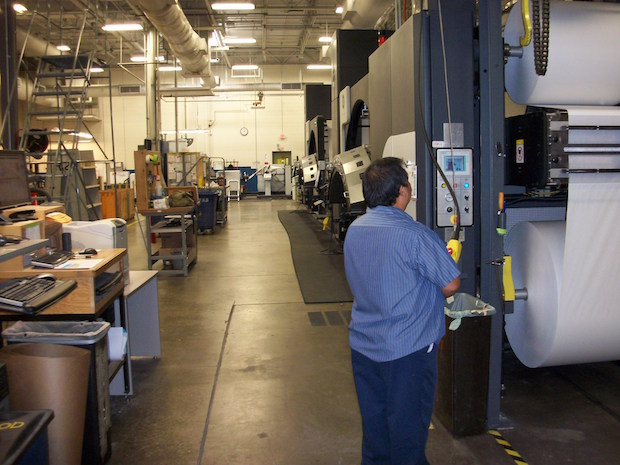
Doua Yang operates the HP PageWide Web Press T360
Thomson Reuters Core Publishing Service began its life in 1872 as part of West Publishing and quickly revolutionized legal publishing. West Publishing was acquired by The Thomson Corporation in 1996, and Thomson acquired Reuters in 2008, creating Thomson Reuters. There are more than 400 employees in the company’s single 1.3 million square foot production facility located in Eagan MN. The shop has 400 different pieces of equipment it uses to deliver 4.6 million subscriptions, along with 1.2 million new orders, annually.
“Our core competency is single color short- and long-run production on lightweight paper,” says Larry Soler, Director of the company’s prepress, press and digital departments. “We’ve found an interesting niche in this space beyond our legacy legal work.
Among its 400 pieces of equipment, CPS had five roll-fed production toner presses and several offset web presses. “We were looking to optimize our digital production platform,” added Tim Hughes, Director, Manufacturing Client Services. “Our forecast showed declining run lengths that would result in the need to produce 25% of all printed pages using digital technology by 2020, and we needed more efficiencies than we could get from our toner-based presses.”
CPS chose to invest in an HP PageWide Web Press T360 to meet these needs and carry the company into the future. “Inkjet technology has emerged as the dominant platform for lowering short run printing costs,” Hughes commented, “and in our business, the standardization of papers and trim sizes made faster inkjet engines appealing to drive those savings.”
In order to drive further efficiencies, CPS worked with HP and Magnum to put a Magnum Flexbook in line with the press. “This is a roll-to-glued-book-block workflow that presents book blocks to our bindery for finishing of case binding and soft cover books,” Hughes says.
This configuration has proven itself. According to Soler, CPS’ record run was 6.5 million pages in a 24-hour period. “There is no way we could have done this without our HP T360,” he says. “Web offset would have required collating, and even our five toner-based presses didn’t have that much capacity.” The company’s inkjet press began operations in January of 2016. In the first half of the year, it produced more than 500 million pages, a stunning achievement.
As a result of this added capacity, CPS was able to eliminate three of its five roll-fed toner presses and move some additional work from its web offset operation to get to those volumes quickly.
CPS indicates that there is no plan to move to 4-color printing. “While we are seeing run length declines in our legal publishing business,” Soler states, “we have found that we are very competitive in this monochrome space to backfill work. We partner well with publishers and other printers to provide solutions that work for our customers.
While Soler and Hughes declined to offer a fixed cross-over point between offset and digital, they did report that the HP T360 has enabled them to move longer runs than anticipated from web offset to inkjet due to the efficiency of inkjet printing with the inline finishing. “We are able to run more pages digitally than we would have in the toner world,” Hughes says. “The decision about which printing technology to use depends on the cutoff, the type of paper required and where our capacity constraints are in the plant. It is not unusual for this analysis to determine that a job could go either way.”
In doing its due diligence, CPS looked at a number of options before investing in the HP T360. “What drew us to HP,” Soler says, “is the combination of speed and quality the press would bring us for the stocks of paper we run. The Magnum Flexbook inline completed this solution for us. HP has been a solid partner. They helped us think out of the box about the different ways we can use the press. And we really appreciated the project plan they put together for us for the installation of the press. That got us up and running right away as our first half of the year performance clearly demonstrates.”
Successful project lead, Mark Keene, credits the quick ramp up in CPS to the wonderful work by the T360 crews, front end operators, schedulers, engineering, sourcing and bindery staff that quickly collaborated and adapted to the inkjet operations and workflow changes. It takes a full team to make this type of project such a success!















Discussion
By Paul Gardner on Sep 20, 2016
Love the flexible thinking:
(CPS) declined to offer a fixed cross-over point between offset and digital... “The decision about which printing technology to use depends on the cutoff, the type of paper required and where our capacity constraints are in the plant. It is not unusual for this analysis to determine that a job could go either way.”
For anyone involved in HP PageWide web printing, checkout the Jetcomm group on LinkedIn:
https://www.linkedin.com/groups/6877744
Discussion
Only verified members can comment.